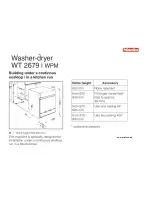
1. Notes on correct laundry care
28
Points to note regarding
washed laundry
– When washing very heavily soiled
items ensure that you use sufficient
detergent and select a high temperat-
ure. If in doubt, wash the items sev-
eral times.
– Do not put soaking wet items into the
tumble dryer. Make sure your laundry
is thoroughly spun before drying. The
higher the spin speed, the greater the
savings that can be made in energy
and time during drying.
– New dark coloured garments should
be washed and dried separately from
light coloured garments to avoid the
danger of colours running and discol-
ouring other garments or even plastic
components in the dryer. Dark col-
oured fibres can also settle on light
coloured garments and vice versa.
– Starched laundry can be dried in the
tumble dryer. To achieve the usual
finish, double the amount of starch
should be used.
Preparing the laundry before
drying
Damage due to foreign objects
which were not removed from the
laundry.
Foreign objects can melt, burn, or
explode.
Ensure that any foreign objects, e.g.
detergent dispensing balls, lighters,
etc. have been removed from the
laundry.
Risk of fire due to incorrect use
and operation.
The laundry can burn and destroy
the dryer and the surroundings.
See “Warning and Safety” instruc-
tions for further information.
– Sort the laundry according to the type
of fibre and weave, size, garment
care label symbol and the drying level
required.
– Check seams and stitching to ensure
that padding and linings are intact.
This way you will avoid the danger of
fillings coming out. These could catch
fire when being dried.
– Disentangle the laundry.
– Tie together textile belts and ties.
– Fasten duvet covers and pillow cases
to prevent small items from being
rolled up inside them.
– Fasten hooks and eyes.
– Leave jackets open and undo any
long zips so that textiles dry evenly.
– Sew in or remove underwiring from
bras.
– If necessary, reduce the size of the
load for these types of fabric. Easy
care fabric tends to crease more, the
larger the load. This is particularly the
case for garments made from very
fine weave fabric, such as shirts or
blouses.
















































